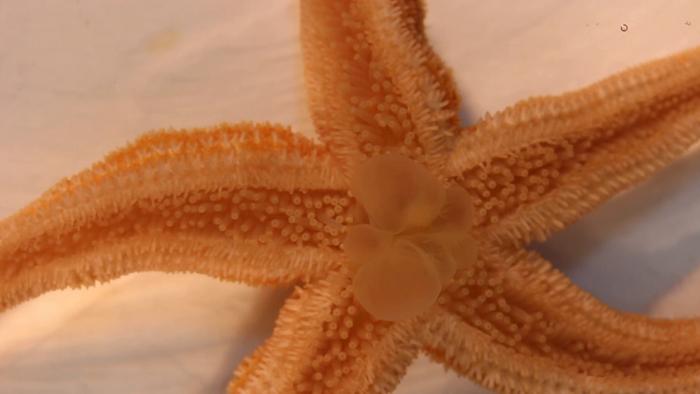A groundbreaking study conducted by a team of biologists at Queen Mary University of London has highlighted the evolutionary legacy of a neurohormone that plays a significant role in appetite regulation in both humans and marine organisms. The research, published in the esteemed journal “Proceedings of the National Academy of Sciences USA,” reveals that the neurohormone known as bombesin has an ancient origin, traceable back over 500 million years. This study not only sheds light on hunger regulation mechanisms in vertebrates but also opens intriguing avenues for research on invertebrates such as starfish, with revealing implications for our understanding of appetite control across species.
Bombesin is a small peptide that functions as a satiety signal, directly influencing the sensation of fullness by acting on specific receptors in the brain and gastrointestinal tract. While it might seem surprising to discover such a complex physiological function in organisms far removed from mammals, the findings indicate that bombesin-like neurohormones date back to a common ancestor of humans and echinoderms, including starfish. This deep evolutionary connection suggests that the fundamental mechanisms regulating hunger have been conserved across vast timelines and divergent lineages in the animal kingdom.
The nomenclature of bombesin adds a layer of historical curiosity. Its name stems from the fire-bellied toad, Bombina bombina, from which it was first isolated in the early 1970s. Initial research showed that bombesin administration in mammals notably decreased meal sizes and increased intervals between meals, leading researchers to hypothesize that bombesin and its analogs, originating in the brain and gut, contribute significantly to the intricate web of appetite regulation. As a result, current pharmacological developments are focused on leveraging this evolutionary knowledge, with compounds mimicking bombesin’s effects emerging as promising candidates for obesity treatment.
In the recent study, Professor Maurice Elphick, along with his research team, aimed to trace the history of bombesin-like neurohormones. By analyzing the genomic data of various invertebrates, they unearthed genes coding for bombesin-like neuropeptides in multiple echinoderms, including the common starfish, scientifically known as Asterias rubens. This effort required advanced bioinformatics techniques akin to searching for a needle in a haystack, as many evolutionary connections had been lost over eons. The successful identification of these genes marks a significant advancement in our understanding of the evolutionary adaptations of appetite regulation mechanisms across diverse taxa.
Further investigations into the neuropeptide discovered in starfish, termed ArBN, were pivotal in understanding its physiological role. Advanced mass spectrometry techniques enabled researchers at the University of Warwick to elucidate the molecular structure of ArBN, facilitating its synthesis for functional studies. The experiments conducted involved evaluating how ArBN impacted the feeding behavior of starfish, a unique process where these creatures evaginate their stomachs to digest prey, such as mollusks. This feeding strategy, different from those of most other animals, adds to the complexity of analyzing appetite regulation in such invertebrates.
Dr. Weiling Huang, an essential figure in this research, led the experimental assessments on the functional implications of ArBN in starfish. Upon injection of this peptide, Dr. Huang observed notable contraction of the starfish’s stomach—an indication that ArBN effectively stimulates stomach retraction upon ceasing feeding activities. This finding supported the hypothesis that ArBN plays a critical role in mediating feeding cessation, aligning with bombesin’s functionality in vertebrates. Additionally, it was revealed that starfish injected with ArBN exhibited a delayed response in initiating feeding, taking longer to capture prey compared to their control counterparts, who received only water.
The revelation of bombesin’s ancient lineage and its role in appetite regulation has broader implications for evolutionary biology and ecological management. The findings grant valuable insight into the evolutionary pressures shaping feeding behavior and neuroendocrine functions in diverse animal lineages. Importantly, as climate change catalyzes shifts in marine habitats, certain starfish species have begun to invade new territories, where they threaten shellfish populations cultivated for human consumption. Understanding the biochemical pathways that govern feeding in starfish, including the actions of neuropeptides like ArBN, could directly aid in developing strategies to mitigate such ecological invasions.
In light of these results, the implications extend into the realm of pharmacology as well. The similarities in appetite regulation mechanisms shared between echinoderms and vertebrates suggest that studying invertebrate models like starfish can yield critical insights for human health applications, particularly concerning metabolic disorders such as obesity. The potential for analogs of bombesin to function in therapeutic contexts illustrates the practical applications of understanding these ancient neurohormonal systems.
The research was generously supported by prominent institutions including the BBSRC, the China Scholarship Council, and the Leverhulme Trust, reflecting a collaborative spirit across geographic and disciplinary lines. Such interdisciplinary approaches are vital to unraveling complex biological systems and can pave the way for innovation prompted by integrative research findings. As scientists continue to explore the intricate web connecting evolutionary biology, physiology, and pharmacology, the research surrounding bombesin serves as an exemplar of how ancient biological mechanisms can influence contemporary challenges.
In conclusion, the discovery and functional characterization of the bombesin-type neuropeptide signaling system in an invertebrate show an astonishing continuity in neuroendocrine regulation of appetite across evolutionary history. This revelations not only bridge the apparent gaps between human physiology and invertebrate biology but also highlight the shared biological heritage that underpins the functioning of diverse life forms.
The quest for knowledge spanning evolutionary timelines transforms our comprehension of biological systems and informs future research directions that can enhance both ecological conservation and human health.
Subject of Research: Evolutionary history of appetite regulation mechanisms in invertebrates and their implications for human health.
Article Title: Discovery and functional characterization of a bombesin-type neuropeptide signaling system in an invertebrate
News Publication Date: 24-Mar-2025
Web References: http://dx.doi.org/10.1073/pnas.2420966122
References: Proceedings of the National Academy of Sciences
Image Credits: Weiling Huang
Keywords: appetite regulation, bombesin, evolutionary biology, neurohormones, obesity, invertebrates, starfish, biochemistry, pharmacology, ecological management, metabolic disorders, feeding behavior.




